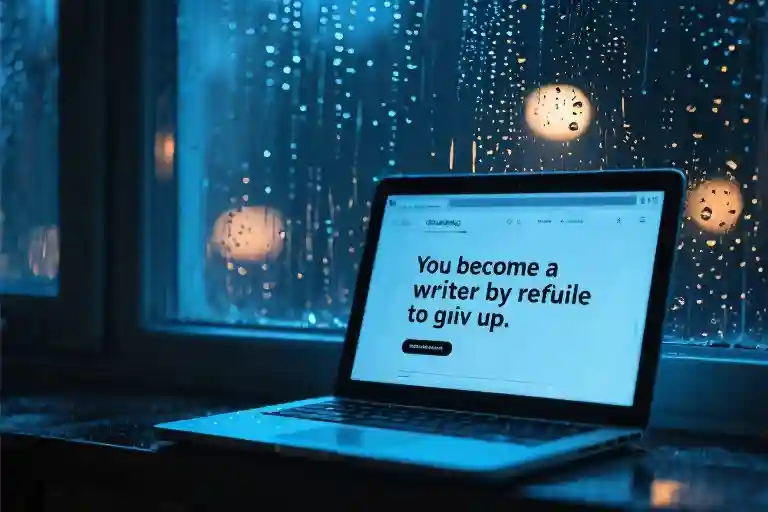The blue glow from my laptop screen reflected off the rain-streaked window, casting jagged light patterns across the rejected submission email. My right hand hovered over the keyboard, index finger trembling slightly above the delete key. In the corner of the screen, the analytics dashboard showed another day of declining readership – 37 views, down from 112 last week. The numbers pulsed like a fading heartbeat monitor.
Outside, the rhythmic tapping of rain against glass formed a strange synchronization with my compulsive email refreshing. Each F5 press brought nothing but that soul-crushing empty inbox icon. My shoulders had locked into permanent tension hours ago, the muscles forming concrete knots no amount of stretching could loosen. At 2:47 AM, my dry eyes burned from staring at the same half-written paragraph about ’10 Productivity Hacks’ that suddenly seemed laughably irrelevant.
Creative resilience felt like a cruel joke in moments like these. The writing process that once sparked joy now only produced acid reflux and self-doubt. My draft folder overflowed with abandoned pieces – ‘Why Your First 100 Pieces Will Suck’ (unfinished at 327 words), ‘Dealing with Content Creator Burnout’ (deleted in frustration). Every unpublished document whispered the same poisonous thought: maybe you’re just not good enough.
The notification ping made me jump. Another form rejection from The Writing Cooperative, this one with that particularly devastating line: ‘While your piece shows promise, it doesn’t quite meet our current needs.’ My stomach dropped as it always did, that familiar free-fall sensation writers know too well. I counted – this made rejection number 14 this month. My finger finally stabbed the delete key with unnecessary force.
Writer’s block solutions flooded my browser history: morning pages, pomodoro techniques, writing sprints. None of them addressed this hollow feeling that maybe I was wasting my time. The rain intensified outside, matching my growing despair beat for beat. What was the point of overcoming rejection as a writer if the work itself stopped meaning anything?
Then – I can’t explain why – my restless scrolling stopped on a forgotten bookmark. A minimalist blog with plain black text on white background: ‘You don’t become a writer by waiting to be discovered. You become one by refusing to give up.’ The words appeared simple, unremarkable really. But something about their naked honesty bypassed my cynicism entirely. My breathing slowed without conscious effort.
In that moment, I noticed two things simultaneously: the rain hadn’t stopped, but my relationship to its sound had changed. What was earlier an oppressive rhythm now simply existed as background noise. And for the first time in weeks, I felt curiosity rather than dread toward the blinking cursor. Not motivation exactly – more like the faintest possibility that writing motivation techniques might actually work if I stopped measuring success by metrics that currently defined it.
The half-finished ‘Productivity Hacks’ document still glared at me, but now with less accusation. I created a new file instead, titling it simply ‘Day 1’. The content wouldn’t matter – not really. What mattered was the act of showing up, of treating writing as something separate from validation. Outside, the storm continued its relentless pattern. Inside, something quiet and determined began to grow.
The Writer in the Emergency Room
The cursor blinked mockingly on the screen, synchronizing with the irregular rhythm of rain hitting my apartment window. My right hand hovered over the keyboard, fingers trembling not from cold but from the aftereffects of reading that fifth rejection email this month. The notification still burned in my peripheral vision: “We appreciate your submission but…”—the literary equivalent of a doctor saying “It’s not you, it’s me” before walking out.
I’d developed what veteran writers might recognize as acute creative distress syndrome. The symptoms manifested in predictable cycles:
Psychological indicators:
- Compulsive dashboard refreshing (every 12 minutes according to Screen Time)
- Paranoid DM checks (did that editor read but ignore my pitch?)
- Retroactive editing of published pieces (that comma in paragraph three suddenly seemed catastrophic)
Physical manifestations:
- Shoulder muscles locked in permanent tension (my trapezius could substitute as marble countertops)
- Eyeballs desiccated from 3am scrolling sessions (when all decent writers are supposedly sleeping)
The pathogens feeding this condition were equally identifiable:
Toxin A: Algorithm Poisoning
Every platform kept serving me “How I Got 100K Followers in 30 Days” case studies. These viral success stories functioned like Instagram filters for reality—making my modest readership stats appear even more grotesque in comparison.
Toxin B: Contagious Hustle Culture
Fellow writers’ LinkedIn posts about their “5AM writing rituals” and “yearly content calendars” induced feverish imposter syndrome. Their disciplined routines made my haphazard creative process feel like artistic malpractice.
What began as mild creative self-doubt had escalated into full-blown writer’s block. The metrics obsession had rewired my brain—I could now estimate word counts by pixel length and predict engagement rates based on headline formulas. Somewhere between chasing trends and analyzing heatmaps, I’d lost the thread of why I started writing in the first place.
The rain intensified outside, its percussion matching my frantic keyboard taps as I deleted another half-finished draft. My writing space had become a self-inflicted ICU, with me as both patient and incompetent attending physician. The diagnosis was clear: I needed to stop treating writing like a performance and remember it’s fundamentally about the quiet, stubborn act of showing up—even when (especially when) no one appears to be watching.
The Lightning Outside and the Storm Within
The laptop screen flickered as another thunderclap shook the window. Raindrops blurred the text on a forgotten blog tab that had been open for weeks. My thumb hovered over the trackpad, about to close all thirty-seven unfinished drafts when a serif font caught my eye.
“You don’t become a writer by waiting to be discovered. You become one by refusing to give up.”
The words appeared in 14px Georgia against a cream background – utterly ordinary typography that somehow bypassed my visual cortex and went straight to whatever part of the brain stores childhood memories. The screen’s blue light mixed with flashes of lightning outside, creating a strobe effect that made the sentence appear to pulse.
I noticed three physiological changes in rapid succession:
- My shoulders dropped two inches without conscious instruction
- A warmth spread through my chest that had nothing to do with room temperature
- The acidic taste of three coffees suddenly registered on my tongue
Neuroscience would call this an “aha moment” – that instant when the prefrontal cortex reorganizes existing neural pathways to accommodate new understanding. Mine arrived with the subtlety of a lightning strike. The rejection emails (twelve this month), the abandoned drafts (nineteen in the last quarter), the obsessive analytics checking (every 47 minutes on average) – they weren’t evidence of failure but of practice.
Creative resilience isn’t about avoiding the storm; it’s about rewiring your brain to dance in the rain.
As the downpour intensified outside, something peculiar happened to my internal monologue. The usual “you’re not good enough” recording paused mid-sentence, replaced by a calmer voice asking: “What if persistence is the only skill that matters?” Dopamine – that sneaky neurotransmitter – began constructing new pathways between my frustration and determination.
I opened a fresh document and titled it “Lightning Log.” The first entry read:
- 8:17pm: Realized I’ve been measuring my writing career in outcomes when I should have been counting revolutions around the sun. Every orbit completes whether anyone applauds or not.
Outside, the storm showed no signs of abating. But inside, the barometric pressure of my creative atmosphere had shifted. The same rain that an hour ago sounded like a taunt now provided perfect white noise for typing. My fingers found the home row keys as naturally as breathing, and for the first time in months, I wrote without imagining an audience’s reaction.
The blog’s advice hadn’t magically solved my problems. But it had done something more valuable – it reminded me that writer’s block solutions often come disguised as simple truths we knew but forgot to believe. That creative resilience grows strongest when watered with small, daily acts of defiance against self-doubt.
Thunder rattled the windows again as I saved the document. The storm would pass eventually. Until then, I had words to write and neural pathways to rebuild – one lightning strike of insight at a time.
Cultivating Creative Immunity
The cursor blinked mockingly on a half-finished paragraph about resilience. My fingers hovered over the keyboard, paralyzed by the mental math I’d been doing all morning – 37 rejections this year, 128 unanswered pitches, analytics graphs that looked like alpine ski slopes. This wasn’t writer’s block; this was writer’s collapse.
Petrie Dish Protocols
Culture Medium #1: The 200-Word Antidote
Every morning before checking emails, I began depositing words into a password-protected document titled ‘Laboratory Waste.’ No outlines, no editing, just 200 words of deliberately bad writing – grocery lists mingling with existential dread, song lyrics interrupting half-baked metaphors. This daily microbial ritual served two purposes: it lowered the stakes of creation, and more importantly, it inoculated against the paralysis of perfectionism. The words didn’t need to be good; they simply needed to exist.
Culture Medium #2: The Data Quarantine
For three Wednesdays each month, I activated what neuroscientists call ‘cognitive disengagement’ – no analytics dashboards, no social media metrics, just a spreadsheet tracking one primitive metric: ‘Words Released Into Wild.’ The rules were simple: if words left my editing platform, they counted as vaccinated against outcome anxiety. Some weeks the count reached thousands; other times just a stubborn 250. The numbers didn’t matter nearly as much as rebuilding the eroded connection between creating and satisfaction.
Pathogen Identification
Creative viruses mutate faster than medical science can name them, but three strains account for most epidemics:
- Comparison Fever: That burning sensation when scrolling through someone else’s viral post while your draft folder coughs weakly in the background
- Shortcut Syndrome: The dangerous belief that some new tool, template, or tactic will bypass the necessary work of developing craft
- Metric Malaria: Cyclical chills and fevers triggered by the relentless refresh button, where self-worth becomes hostage to algorithms
Antibody Development
The treatment protocol involved creating a ‘Quotation Bank’ – not the usual inspirational posters, but specific counter-statements for each virus strain. When comparison fever spiked, I’d administer: ‘The only sustainable competition is with yesterday’s version of yourself.’ For shortcut cravings: ‘Mastery lives in the thousandth repetition, not the first hack.’ And when metric obsession threatened: ‘Numbers measure reach; they never measure reason.’
This wasn’t about positive thinking. It was about cognitive bioengineering – deliberately rewiring the mental pathways that equated external validation with creative worth. Some days the antibodies held strong; other days the infection broke through. Progress wasn’t linear, but the relapses became less frequent, the recovery periods shorter.
Viral Load Management
The breakthrough came when I stopped viewing rejections as system failures and began treating them like vaccine boosters – small, controlled exposures strengthening creative immunity. Each ‘not for us’ email became data for refining my work’s compatibility with different platforms. The brutal comments section trolls? Extreme stress tests for maintaining artistic integrity under fire.
Creative resilience isn’t about avoiding infection; it’s about developing enough antibodies to keep creating through the fevers. My laboratory notebook now charts two parallel metrics: output volume and recovery speed. The goal isn’t to stop getting sick – it’s to shorten the time between ‘I’m worthless’ and ‘What’s next?’
The Alchemy of Rain Sounds
The same raindrops that drummed a funeral march against my windowpanes now hum as white noise in my writing sessions. That night’s storm never truly ended—it just changed frequency. Where I once heard condemnation in every plink against glass (“: you’re not good enough”), I’ve learned to detect the rhythm of creative resilience.
Toolkit for Weatherproof Writing
Scan this QR code to download your Creator’s Weather Station template—part journal, part barometer for tracking creative pressure systems. You’ll find:
- A Precipitation Tracker to log rejection emails alongside their silver linings
- Atmospheric Pressure Charts mapping motivation spikes to circadian rhythms
- The legendary 100-Day Monsoon Challenge that transformed my relationship with failure
I keep mine taped above my desk, coffee-stained and dog-eared from use. Last week’s entry reads: “Thunderstorm warning—3 rejected pitches. But the cirrus clouds of a new essay formation spotted near the prefrontal cortex.”
Shelter for Storm-Chasers
We’ve built a secret clubhouse for writers who work best to the sound of rain. No polished success stories allowed—just real people trading survival strategies like:
- How to distinguish between healthy pruning and creative self-amputation
- The art of cultivating useless writing gardens (where the best ideas often sprout)
- Rituals for weathering algorithm droughts
Whisper “petrichor” (that earthy scent after rain) to the doorbot at @RainyDayWriters. Your first round of virtual tea is waiting.
This isn’t where the story ends. It’s where we stop pretending storms are interruptions to creative work, and start recognizing them as the very conditions under which our best writing takes root. Your monsoon season might look different—hailstorms of self-doubt, maybe, or the slow erosion of imposter syndrome—but the same laws of creative meteorology apply.
When the next downpour comes (and it will), you’ll hear more than noise. You’ll catch the morse code of persistence in every drop: keep going, keep going, keep going.“





